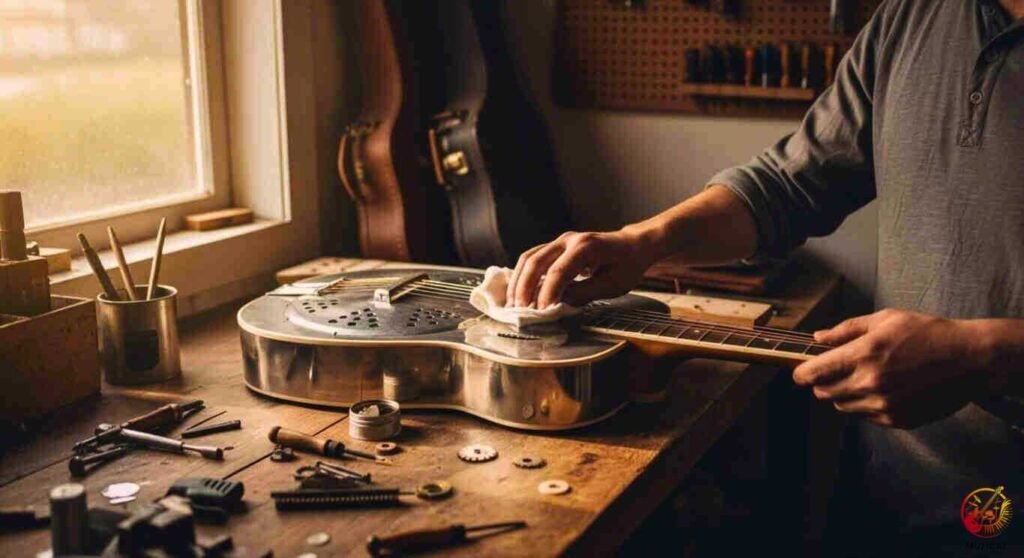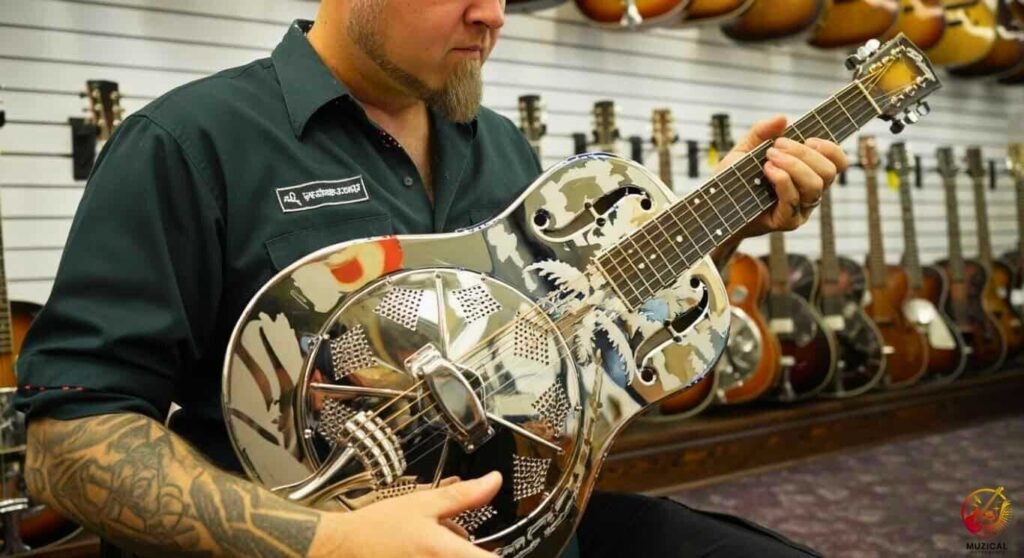How to Breathe Life Into a Dull Resonator Cone: Simple Fixes That Work
Your dull resonator cone is not dead, it’s just tired. Over time, tiny changes happen: dirt, oxidation, micro damage, misalignment. These change how the cone vibrates. When that happens, your resonator guitar sounds weak, flat, or lifeless.
In this article, you will discover:
- Why a resonator cone loses tone
- How to diagnose a dull cone
- Step by step methods to restore it
- When to repair vs when to replace
- Tips to keep the cone alive longer
Let’s get your resonator singing again.
Why Your Resonator Sounds Dull in the First Place
So, your resonator guitar sounds flat and lifeless? Don’t rush to buy a new cone yet. In most cases, the cone isn’t the real problem. A small issue elsewhere, loose parts, bad seating, or dirt can easily kill your tone. Let’s check the most common causes first.
The Top 5 Culprits Behind a Lifeless Tone:
- Dead Strings: This is the #1 offender. Old, grimy strings lose their ability to vibrate properly. They can’t transfer enough energy to drive the cone.
- Improper Seating: The resonator cone must sit perfectly flat and make even contact with the lip of the soundwell inside the guitar. Any gaps, even tiny ones, will kill resonance and sustain.
- Dirt and Debris: Dust, grime, and tiny particles can accumulate on and under the cone over time. This added mass dampens vibrations, acting like a mute.
- Saddle or Bridge Issues: A poorly fitted saddle, the wrong material, or an improperly adjusted spider bridge tension screw can prevent the string vibrations from reaching the cone effectively.
- A Damaged Cone: Yes, sometimes the cone is the problem. A dent, a warp, or metal fatigue from years of playing can cause a dull resonator cone. This is especially common with cheaper, factory stamped cones.
How to Tell If the Cone Is the Problem

You don’t want to rip it out immediately. First, some checks to confirm the cone is dead or dying.
| Check | What You Do | What Might It Show | Interpretation |
|---|---|---|---|
| Remove cover & visually inspect | Unscrew cover plate, see the cone surface | Dents, discoloration, corrosion, gaps | Damage or oxidation is visible |
| Tap test | Very gently tap at center or edge | A dull “thud” vs crisp ring | A healthy cone rings; a dull one mutes quickly |
| Check alignment | Observe spider legs contact, cone edge seating | Gaps, misfit, bending | Misalignment means energy leaks |
| Rattle / buzz test | Press lightly on cone while strumming | Buzz, chuff, inconsistency | Loose parts or hardware issues |
| Compare to another cone (if available) | Swap with known good cone for test | Better tone returns | Confirms cone is culprit |
If multiple signs point to the cone (not strings, not nut, not bridge insert), you proceed.
Step by Step: How to Breathe Life Back into a Dull Resonator Cone
When your resonator loses its shine and tone, it’s often a sign of buildup, wear, or poor contact inside. Follow these simple steps to bring the sound back to life.

Step 1: Perform a Thorough Check and Cleaning
Over time, dust, skin oil, and metal oxidation can rob your resonator of brightness. A careful cleaning can often restore some of its sparkle.
Loosen the strings
Start by detuning the strings until there’s no tension left. This makes it safe to work inside the guitar.
Remove the coverplate
Use a small screwdriver to unscrew the coverplate. Lift it off slowly. Underneath, you’ll see the cone and bridge assembly.
Clean the cone
Use a non corrosive polish, microfiber cloth, or a can of compressed air. Gently remove dust and dirt from the aluminum surface. Don’t press hard, the cone is very thin and bends easily.
Inspect the soundwell
The soundwell is the shelf where the cone sits. Look for glue bits, lacquer drops, or debris that could block full contact. Use a small scraper or chisel to clean the ledge smooth.
Re seat the cone
Place the cone back into the soundwell. Tap lightly around its rim with your finger to help it sit flat. Try rotating it a little, sometimes one position gives a better, tighter fit than others.

Step 2: Adjust the Spider Bridge
If your guitar uses a spider bridge (common in Dobro style resonators), setup here makes a big difference in tone and volume.
Ensure the spider is level
Place the spider bridge on a flat surface. All legs should touch evenly. If one is off, gently bend it until everything sits level.
Check the tension screw
The small screw in the center connects the spider to the cone. It must be snug, not tight.
Here’s how to find the sweet spot:
- Tune the guitar to pitch.
- Loosen the screw slowly until you hear a rattling or fuzzy buzz.
- Tighten it back in small ¼-turn steps until the buzz disappears.
If you go too far, the sound will choke, so stop once it’s clear and open.
Step 3: Check and Replace the Saddle
The saddle transfers the vibration from the strings into the bridge and cone. If it’s worn, tone will suffer.
Examine for wear
Look closely at the string slots. If they’re too deep or rough, they can cause buzzing. Replace the saddle if needed.
Adjust height for tone
Saddle height changes how much pressure the strings put on the cone. A higher saddle pushes down harder and gives more volume. A lower one softens the tone. Adjust carefully to find your sweet spot.
Step 4: Replace the Resonator Cone
If cleaning and setup don’t bring back the sound, the cone itself may be worn out. Metal fatigue happens after years of vibration. A fresh cone can transform your tone completely.
Cone type
Resonators come in three main types, spider, biscuit, and tricone. Make sure you buy the correct style and size for your guitar body.
Cone quality
Look for hand spun cones made from hardened aluminum alloy. These are lighter and ring longer, giving a bright, bell like tone. Avoid cheaper “stamped” cones, they often sound flat and lifeless.
Lifespan
Even with care, cones wear out. Many pro players replace theirs once a year. Casual players can stretch it to every couple of years. A new cone keeps the guitar’s tone alive and crisp.
With these four steps, clean, adjust, check, and replace, your dull resonator cone can sing again. Each step builds on the last, so take your time, listen carefully, and handle the parts gently. The reward? A tone that feels alive, open, and bright once more.
When Repair Is Not Enough: Replacement & Upgrades
Not all cones can be revived. Sometimes replacement or upgrade is better.
When to Replace
- If there is severe damage: large dents, warps, or cracked rim.
- If micro cracks extend and compromise strength.
- If cleaning did nothing and sound is still weak.
Choosing a Replacement Cone
- Match the alloy, thickness, and type (spun aluminum, etc.).
- Use reputable makers (Beard, Quarterman, etc.).
- Choose one suited to your bridge type (spider, biscuit, tri-cone).
- Be sure fit is precise.
Maintenance Tips to Keep the Cone Alive Longer
Here are things you do before it dulls again:
- Keep cone clean; occasionally dust or blow it lightly.
- Limit humidity swings; moisture can accelerate oxidation or stress.
- Check tightness of internal screws yearly.
- Avoid heavy knocks or bending of guitar (don’t drop).
- Use proper storage (case, padded environment).
- Replace strings one at a time to keep internal parts stable.
- Monitor small changes in tone, act early.
Final Thoughts: It’s All in the Setup
Bringing a dull resonator cone back from the dead is rarely about one magic fix. It’s about a systematic process of cleaning, inspecting, and setting up the instrument’s components to work in harmony.
By following the steps outlined here, you can restore the vibration, clarity, and bark that make these instruments so special. Don’t be afraid to take off that coverplate; the heart of your guitar’s sound is waiting for a little attention.
Now go make some noise! What are your favorite resonator cone care tips? Share them in the comments!
FAQ: How to Breathe Life Into a Dull Resonator Cone
1. Why does my resonator guitar sound so dead and muffled?
Your resonator guitar might sound dull for a few simple reasons. Most often, the problem is just old, dirty strings that can’t vibrate well anymore. It could also be that dust and grime have built up under the cone, or that the cone itself isn’t sitting perfectly flat inside the guitar’s body.
2. How do you clean a resonator cone?
You have to be very gentle. The best way is to use a can of compressed air to blow off any loose dust. For any remaining grime, use a clean, dry microfiber cloth. A key part of resonator cone maintenance is to never use water, polish, or any liquid cleaners, as they can damage the thin aluminum.
3. How can I make my resonator guitar louder?
To get more volume, start with the strings. Resonator guitars need medium or heavy gauge strings to create enough tension to make the cone really sing. A clean cone and a proper setup will also make it much louder. If you want a major boost in volume and tone, upgrading to a quality hand-spun cone is the best thing you can do.
4. Do resonator cones wear out?
A good resonator cone doesn’t really “wear out” from playing. A high-quality cone can last for 20 years or even longer! You only need to think about replacing it if it gets physically damaged, like getting a dent or being crushed by too much pressure from the bridge.
5. Can you fix a dented resonator cone?
Unfortunately, you can’t. The aluminum is very thin and delicate. Trying to push out a dent will usually just stretch the metal and make the dull resonator cone sound even worse. If your cone is dented, the only real solution is to replace it.
6. What kind of strings are best for a resonator guitar?
Always use strings designed for resonator guitars or at least a medium-gauge acoustic set (starting with a .013 on the high E string). Light-gauge strings simply don’t have enough power to properly drive the cone and will leave your guitar sounding weak.
7. Does the wood in a resonator guitar matter?
Yes, it does! While the cone creates most of the sound, the guitar’s body material shapes it. A mahogany body will give you a warmer, darker tone, while a maple body will sound brighter and clearer. Metal-body resonators have their own unique, loud, and ringing sound.
